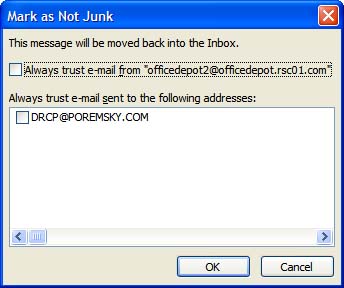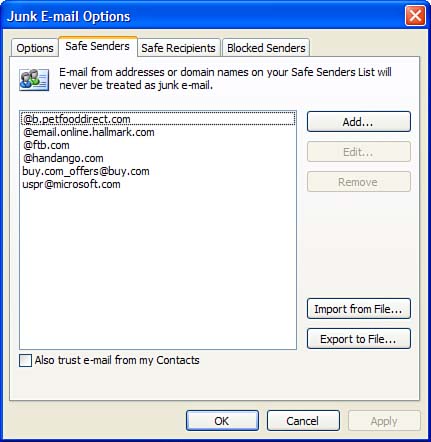Managing Your Junk Mail
| Junk email and spam are a problem everyone faces. It's not hard to get on a spammer's list, but it's difficult to get off the list. Outlook 2003 includes an improved junk mail filter that includes safe senders, safe recipients, and blocked senders lists.
Along with safe lists, you can mark messages that are in the Junk E-mail folder as not junk and the message is moved back to your inbox. When you've moved all the messages out of the folder that were caught by the junk filter, right-click on the Junk E-mail folder and choose Empt y Junk E-mail Folder to permanently delete the messages in the folder. These messages are not moved to the Deleted Items folder and cannot be recovered, so make sure that you remove all the messages that were moved to the folder by mistake before you empty the folder. Access the Junk E-mail settings from T ools, O ptions, Preferences, and clicking the J u nk E-mail button or by right-clicking on any message and choosing J unk E-mail, J unk E-mail Options (see Figure 14.12). Figure 14.12. New to Outlook 2003, the Junk E-mail rules provide much needed spam filtering capabilities. Select the level of filtering you want from this dialog. Use the Junk E-mail Options dialog to set the level of protection you desire :
The final option on this tab enables you to permanently delete all messages suspected to be junk. This is usually a bad idea, especially for the S afe Lists Only and H igh filters. Both options have a high false-positive rate and you risk deleting good mail. When junk filtering is enabled, you can right-click on any message and choose J unk E-mail. The context menu includes menus to
The first four options add the sender, the recipient, or the sender's domain to the appropriate list on the Junk E-mail Options dialog. Junk E-mail Options opens the dialog of the same name , and Mark As Not Junk opens a dialog from which you can select to always trust email from the sender or to the addresses in the To field (see Figure 14.13). After making your section, the message moves back to the inbox. Figure 14.13. Use the Mark As Not Junk dialog to add the sender to your safe sender list and move the message back to the Inbox. Note that when Outlook is first run, the junk filter scans all folders in your message store and messages in other folders might be moved to the Junk E-mail folder. Mark As Not Junk moves the messages back to the inbox only, not to the folder the message was originally stored in. Understanding Safe ListsReal spam fighters don't use the term safe list ; they call the list of addresses and domains that are always allowed to send mail to your address a whitelist . Outlook contains two whitelists : the Safe Senders and Safe Recipients lists. Each list has its own tab on the Junk E-mail Options dialog box, which makes it easier to see who is on which list. The Safe Senders list includes a check box to Also Trust E-mail from My C ontacts (see Figure 14.14). It's enabled by default and should be disabled, especially if you have a contact for yourself. Spammers have already discovered some ways to take advantage of the Safe Senders list and more are expected to follow. Figure 14.14. Enter trusted addresses in the lists on the Safe Senders and Safe Recipients tabs. Use Safe Senders for addresses found in the From field; Safe Recipients is used for addresses in the To field, such as mailing list addresses.
The Safe Senders, Safe Recipients, and Blocked Senders tabs each has A d d, E dit, and R emove buttons that you can use to manage your lists. To remove one address from the lists, select it and click Remove; to remove several addresses, select all of them and click Remove. If you discover that you accidentally added an address to the wrong list, you can copy the address and enter it on the correct list:
Sometimes it's easier to delete the address and type it in on the correct tab, except when the address is long. Using Blocked Senders ListsThe opposite of a whitelist, blacklist is the term used by spam fighters to refer to blocked senders. The Blocked Senders list works like the safe lists, except that any messages received from an email address or domain on the list are moved to the Junk E-mail folder. Outlook doesn't check the message against the content filter, and the message is not processed by any rules. Because the junk filter processes mail before the Rules Wizard, when you want to delete mail from a person or domain, you should use the Blocked Senders list.
Use E x port to File to back up your domain list or to share it with other Outlook 2003 users. Naturally, I m port from File is used to restore your lists. Each list exports to a separate text file, not one file containing all of your safe and blocked senders. |
EAN: 2147483647
Pages: 228


